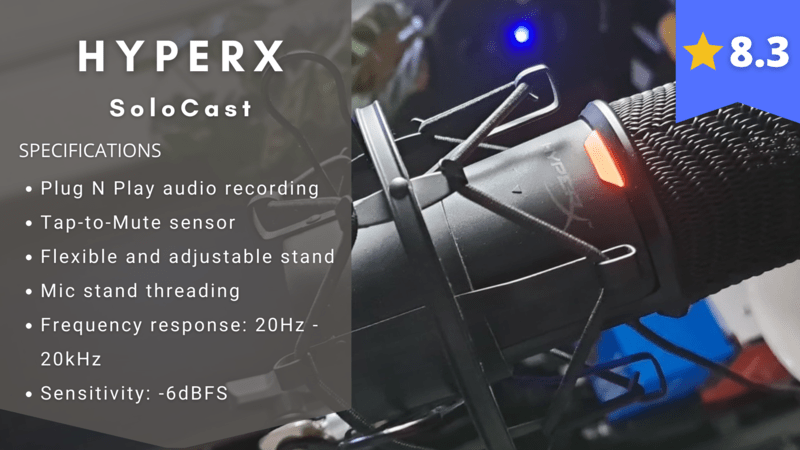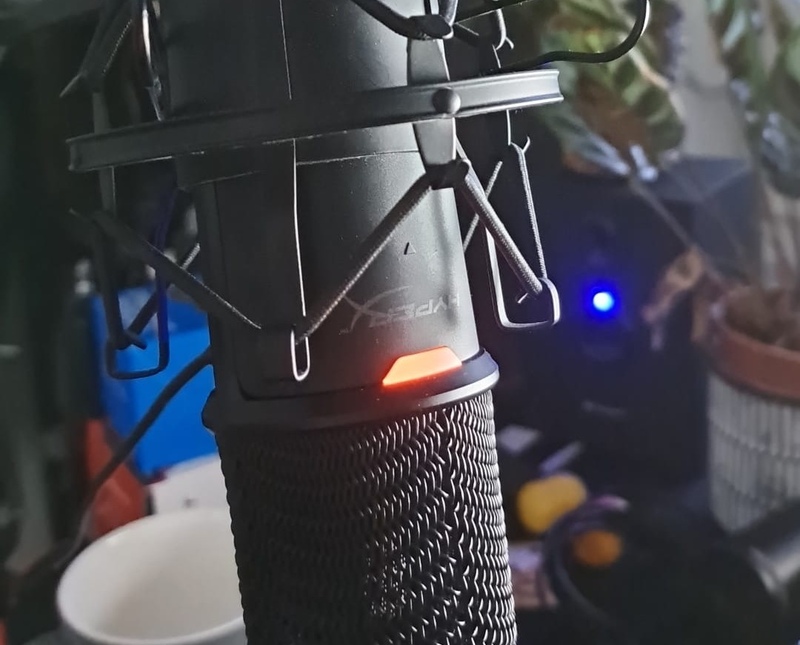Welcome to my review of the HyperX SoloCast! The HyperX SoloCast is a USB condenser microphone crafted to provide high-quality audio recordings for content creators, podcasters, and streamers.
Thanks to its plug-and-play feature, 24-bit/96kHz recording capability, and tap-to-mute sensor, the SoloCast has become popular among those looking for an affordable and user-friendly microphone.
In this review, I will evaluate SoloCast’s performance, advantages, disadvantages, design choices, and provide comparisons to other microphones within its price range.
HyperX SoloCast Review

Stefan’s Take:
Overall, the HyperX SoloCast is a decent USB condenser microphone that offers quality audio recording, easy-to-use features, and a flexible stand.
While it lacks a headphone jack and may require additional software adjustments to eliminate background noise, it is comparable to other microphones in its price range, and its tap-to-mute sensor with LED indicator is a useful and intuitive feature for content creators.
| Sound Quality | 8 |
|---|---|
| Ease of Use | 9 |
| Background Noise Suppression | 8 |
| Value | 8 |
The HyperX SoloCast is a user-friendly and versatile USB condenser microphone that provides high-quality audio recording for podcasters, streamers, and content creators. Having personally used the product, I can evaluate it effectively.
Performance and Benefits:
The SoloCast’s 24-bit/96 kHz recording capability ensures high-resolution audio quality, capturing even the slightest nuances of your voice.
The cardioid polar pattern is ideal for recording voiceovers or podcasts, as it captures sound directly in front of the microphone while minimizing background noise.
The tap-to-mute sensor, featuring an LED status indicator, is an excellent tool for streamers or podcasters who need to mute audio quickly. The LED light clearly shows when you are muted, helping to avoid accidental broadcasting.
Additionally, the flexible and adjustable stand can swivel to accommodate various setups, making it convenient to use.
Drawbacks:
One drawback of the SoloCast is that it lacks a headphone jack, which makes it challenging to monitor your audio levels in real time.
Some users also report that the microphone is overly sensitive, capturing background noise and requiring further software adjustments for resolution.
Another drawback is that it does not come with a pop filter, which can lead to popping sounds when pronouncing certain words or syllables.
Design Choices:
HyperX has developed the SoloCast as an excellent plug-and-play microphone for content creators looking for a quick and simple setup.
The USB-C connection offers a stable and high-speed data transfer rate, which is crucial for high-quality audio recordings.
The flexible stand allows for easy positioning, and the built-in mount adapter is compatible with most mic stands and boom arms, providing users the freedom to customize their setup.
The tap-to-mute sensor, featuring an LED light, is an intuitive design element that enables you to effortlessly mute your audio without needing to modify software settings or controls.

Quantitative Measurements:
The SoloCast offers a frequency response ranging from 20Hz to 20kHz, which is standard for most condenser microphones. It has a sensitivity of -6dBFS, a signal-to-noise ratio of 78dB, and a maximum SPL of 120dB.
These measurements are comparable to those of other microphones within the same price range, such as the Blue Snowball and the Rode NT-USB Mini.
Comparisons:
In comparison to the Blue Snowball, the SoloCast provides higher resolution recording capabilities and a more sensitive cardioid polar pattern, which can be beneficial for voiceovers or podcasts.
However, the Blue Snowball includes a headphone jack, which is beneficial for monitoring audio levels. The Rode NT-USB Mini also features a headphone jack and has a tighter cardioid polar pattern, which aids in reducing background noise.
Useful Resources and Sellers:
For those interested in purchasing the HyperX SoloCast, it is available on the HyperX website, Amazon, VlogsFan, and various other platforms.
Additional helpful resources include product reviews and tutorials on YouTube, as well as the HyperX support page, which provides troubleshooting assistance and FAQs.
Conclusion
In conclusion, the HyperX SoloCast is an excellent USB condenser microphone that provides high-quality audio recordings for content creators, podcasters, and streamers.
Its plug-and-play feature, 24-bit/96kHz recording capability, and tap-to-mute sensor with an LED indicator make it a convenient and user-friendly microphone. However, it lacks a headphone jack, which can complicate monitoring audio levels, and it may require additional software adjustments to reduce background noise.
Despite these drawbacks, the SoloCast remains a strong contender within its price range, and its flexible stand, along with the built-in mount adapter, offers customization options for various setups.
If you are seeking an affordable and user-friendly USB condenser microphone, the HyperX SoloCast is certainly worth considering.



